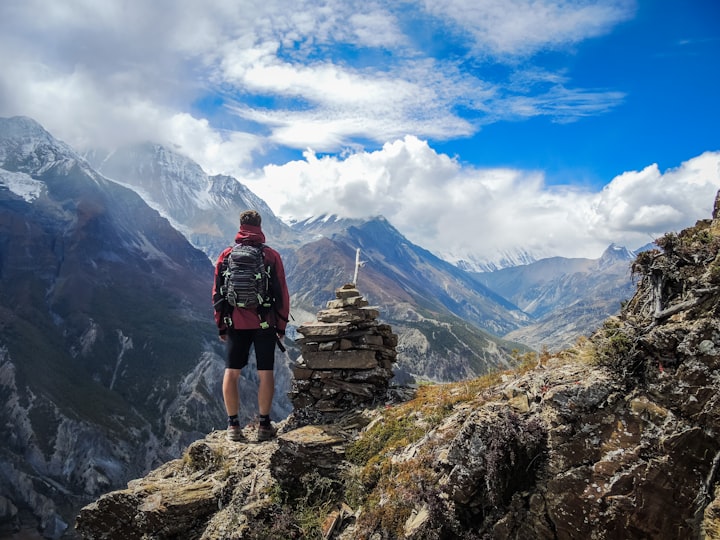Lung Volume + Our Spines
Understanding the connection between breath and backbone

When we view the body holistically it becomes clear that all systems are interrelated.
Our breath supports us. It gives us oxygen. It gives us rhythm. When a yogi falls in sync with their breath, their whole body works in synergy. We act in tandem. Invite your breath to inspire cohesiveness. All systems in our body are supported by breath. If so much is dependent on the simple action of inhaling and exhaling, what supports the breath? One answer is the spine.
The relationship between our spine and lungs is deep. In yoga we can use the spine to change pressure gradients in different lobes of our lungs. We can also use our lungs to move interstitial fluid in the spine. The spine is a delicate extension of the brain. In yoga move with complete awareness of your spine. Go slowly and listen to any tension. Identify what is sweet pain and what is sour pain. Ease up if need be. See if we can move vertebrae by vertebrae with patience the whole way. One thing people may not realize is that we can use the spine to increase or decrease our lung volume, which is what this article will detail.
5-PART SPINAL ANATOMY
First let's divide up the five regions of our spine. At the very bottom of our spine is the coccyx. You may be familiar with this as your tailbone. Our coccyx can have 3-5 vertebrae at birth, but fusion occurs in our 20's. It just becomes one bone. Natural fusion is a means of the body to protect against fracture. However, sometimes the bottommost vertebrae does not fuse. Either way, some flexibility is maintained by surrounding fibrous ligaments. The coccyx plays a role in grounding the muscles of our pelvic floor and moves during activity to balance us.
Above the coccyx is the sacral spine. The sacral spine consists of five vertebrae. Each relate to the functioning of lower parts of our body, such as our hips, groin, and perineal. Just like the coccyx, these bones fuse to form a triangular shape that rests between our hips. It occurs as we mature and is complete by the time a human is 30. Although relatively unusual, in some cases the sacrum completely fuses with the coccyx. The sacrum is our base. The degree of tilt of our sacrum influences all spinal curves above it. This is called the lumbosacral curve and helps support our body weight. Our sacral spine acts as a base for the positioning of all vertebrae above it. This is where our posture comes from, so pay attention to the influence of your hip positioning on your shoulders during yoga and everyday life.
Above the sacral spine is the lumbar spine. This region has a slight natural inward curve, meaning the spine curves forward toward our belly buttons. This is called lumbar lordosis. Lordosis is a medical term which refers to curves which reach their apex at the anterior, or front, of our bodies. Most people have five lumbar vertebrae, but some people have six. The nerves rooted in this spinal region innervate our legs, feet, and genitals. Noteworthy to many yogis, the infamous sciatic nerve branches off from the lumbar spine.
Above the lumbar spine is the thoracic spine. This is the largest region of the spine, composed of twelve vertebrae. It curves naturally backwards, away from our hearts. This is called thoracic kyphosis. Kyphosis is a medical term which refers to curves which reach their apex at the posterior, or back, of our bodies. The thoracic spine has a massive influence on our breathing, because it anchors our ribcage. In fact thoracic vertebrae are defined by their articulation with the ribs. Most of the nerves which originate here become intercostal nerves, working their way through and collecting in the internal matrix of tissues connecting our ribs. These nerves provide for our heart, arms, hands, chest, abdominal organs, and back. Thoracic vertebrae five through eleven receive sensory messages from our diaphragms.
In particular, nerves branching from thoracic vertebrae three, four, and five assist with our breathing. In ancient Chinese Medicine there is a pressure point here called the 'Air Door'. Nerves from thoracic vertebrae three, four, and five innervate our lungs, chest, bronchial tubes, and pleura (membrane which lines the lungs). Displacement of any of these vertebrae can lead to respiratory issues, such as pneumonia, bronchitis, and congestion.
Between thoracic vertebrae four and five is the sternal angle. This is the location where the right and left lungs begin to branch off from the trachea. The sternal angle is also significant for the cardiovascular system. It is the location of our deep cardiac plexus, a bundle of interconnected nerves, blood vessels, and lymphatic vessels which nourish and animate the heart. This is also where our vagus nerve picks up messages from our hearts. This placement is remarkably powerful when considering the support our lungs provide for our hearts. Unfortunately thoracic vertebrae four and five are the most commonly injured of all vertebrae in our spinal column.
Above the thoracic spine is the cervical spine, although we commonly refer to it as our neck. This spinal region naturally curves forward, as if your throat were reaching in front of you. This is called cervical lordosis. The cervical spine plays an important role in breathing, because it supports respiratory organs, such as our trachea and larynx. The cervical spine also provides framework for muscles used in upper chest breathing, which are the sternocleidomastoid and scalene muscles.
Our cervical spine is the origin point for both of our phrenic nerves. Phrenic nerves provide motor input to the diaphragm and allow us the movement of breath. Because breathing is so deeply interconnected to our hearts, phrenic nerves contact the pericardium (a muscular sac which protects our hearts) on their way through our bodies.
EXTENSION AND FLEXION
Our thoracic and cervical spines interact directly with organs in our respiratory system- our lungs and throat. Therefore, these are the two spinal regions where we will have the greatest capability to alter our lung volume.
When our spine is arched backwards our lung volume increases. This position is called spinal extension. When our spine is arches forwards our lung volume decreases. This position is called spinal flexion.
Practice moving with breath with the following exercise:
1. Stand in Tadasana (Mountain Pose).
2. Begin to inhale.
3. Start by filling the deepest part of your spine- the coccyx. As the space becomes full, arch back. Fill your lower torso with breath and move, vertebrae, by vertebrae, up the spine. When you reach the thoracic spine move your arms above the head. Bring your hands together in prayer. As you fill the cervical spine gaze upwards at the thumbs. Gently arch backwards like a crescent moon. Visualize expansion.
4. Hold the breath for a brief moment.
5. Begin to exhale.
6. Begin by releasing your cervical spine to neutral and lowering the arms. Slowly arch forwards as the space in your torso becomes empty. Move slowly, giving each vertebrae time to release. Fold fully forward once your lungs are empty. Plae your hands on the floor or on your legs, whichever is comfortable and does not cause strain. Imagine your torso is sinking and deflating.
7. Repeat this cycle 5-10 times: Spinal extension on inhale and spinal flexion on exhale.
You may have noticed in forms of yoga such as Ashtanga and Kundalini there are asanas which integrate spinal flexion with exhalation and spinal extension with inhalation. This is the natural way to move through yoga. Some forms of Kundalini yoga are practiced almost as if the yogi is able to move their spine without engaging their muscles at all; they are able to move seamlessly through the force of the breath and the changing volume of their lungs.
It is important here to note the state of being between extension and flexion which is called the braced neutral spine. This means none of the discs between our vertebrae are being exerted upon. Try to maintain a braced neutral spine even outside of yoga. To find length in your spine visualize space between the discs.
SPINAL EXTENSION ASANAS
Exalted Warrior Pose / Viparita Virabhadrasana
Warrior One Pose / Virabhadrasana
Camel Pose / Ustrasana
Melting Heart Pose / Anahatasana
Cat Tilt Pose / Bidalasana or Marjariasana
Fish Pose / Matsyasana
Saddle Pose / Supta Virasana
Bridge Pose / Setu Bandhasana
Wheel Pose / Urdhva Dhanurasana
Dancer Pose / Natarajasana
Seal Pose or Cobra Pose / Bhujangasana
Supported Cobra Pose or Sphinx Pose / Salamba Bhujanhasana
Lion Pose / Simhasana
Snake Pose / Sarpasana
Bow Pose / Dhanurasana
Side Bow Pose / Parsva Dhanurasana
SPINAL FLEXION ASANAS
Please be mindful that some of these poses feature lumbar and thoracic flexion while simultaneously holding a cervical extension.
Seated Forward Fold Pose / Paschimottanasana
Cow Tilt Pose / Bitilasana
Plow Pose / Halasana
Standing Head to Knee Pose / Dandayama Janu Sirsasana
Half-Bound Lotus Forward Fold Pose / Ardha Baddha Padmottanasana
Pyramid Pose / Parsvottanasana
Crane Pose / Bakasana
LATERAL STRETCH
Lateral stretching can also be used as a tool to manipulate lung volume. When we compress one side of our torso and allow the other to expand air behaves differently in our bodies. You can fill different lobes of the lungs based on lateral body positioning. Our right lungs have three lobes while our left lungs have only two. Keep this is mind as you experiment with lateral stretching and breathing.
Lateral stretching is also an excellent way to increase lung volume over time, because it increases intercostal flexibility. When the intercostals are more flexible we can breathe easier and have the potential opportunity to take bigger breaths. Focus on relaxing.
LATERAL STRETCH ASANAS
Standing Side Bend Pose / Parsva Urdhva Hastasana
Triangle Pose / Trikonasana
Banana Pose / Bananasana
Revolved Head-to-Knee Pose / Parivrtta Janu Sirsasana
About the Creator
Alice Abyss
Adventure is calling...
My debut novel is coming soon <3






Comments
There are no comments for this story
Be the first to respond and start the conversation.